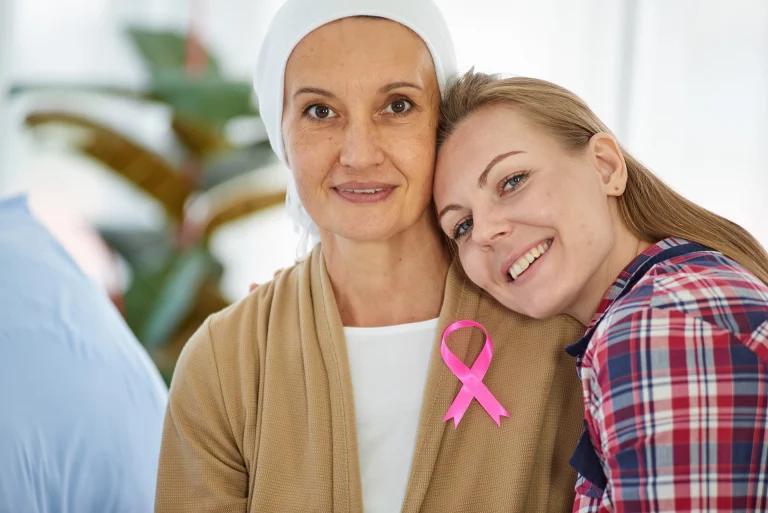Hodgkin’s lymphoma is widely recognised as one of the most treatable types of cancer. Cancer UK statistics predict that 55% of people with non-Hodgkin lymphomas will survive their cancer for 10 years plus after diagnosis and 85% of people with Stage 4 Hodgkin lymphoma will survive for 5 years plus after diagnosis.
Lymphoma often becomes terminal at stage 4. During this advanced stage, it has spread to further areas of the body, such as the liver, lungs, or bone marrow, leading to complications that can turn fatal, including serious infections and liver damage. However, stage 4 lymphoma isn’t always terminal, survival rates for advanced lymphoma depends on the form. Before we look into the staging of lymphoma lets dive into what lymphoma and the lymph system is.
📝 The lymphatic system
The lymphatic system operates as part of the body’s immune system, which protects against infection and disease. White blood cells (lymphocytes) play an important role in fighting disease.
The lymphatic system also maintains fluid balance, aids in digestion and acts as your body’s natural detox system by clearing out waste and toxins. The lymphatic system includes the spleen, thymus, lymph nodes and lymph channels, as well as the tonsils and adenoids. The six lymphatic points in the body include the:
- Collar bone (both sides)
- Behind the angle of your jaw
- Shoulder joint/armpit region
- Abdomen
- Groin area
- Behind your knee
📝 What is lymphoma?
There are two types of lymphocytes or white blood cells, called T cells and B cells. In lymphoma something goes wrong when a single lymphocyte undergoes an unnatural change (mutation) and becomes a cancerous lymphoma cell. Eventually healthy cells are crowded out and the cancer cells multiply and build-up in the lymph nodes and other parts of the body.
Some risk factors may increase your risk of developing lymphoma:
- Age
- Overall health
- Gender, more common in males
- Having a medical condition that already weakens your immune system
- Family history
- Previous exposure to the Epstein-Barr/Herpes viruses
A diagnosis of lymphoma usually involves referral to the oncology department, involving a physical exam to check for swollen lymph nodes, blood tests to rule out other forms of infection or disease and a biopsy of lymph node to test for cancerous cells.
📝 Different types of lymphoma
Hodgkin lymphoma (HL)
Classic Hodgkin lymphoma is the most common form of this disease, typically starting above the diaphragm in the neck, armpits, or chest.
Non-Hodgkin lymphomas (NHL)
The two most common subtypes of non-Hodgkin lymphoma are diffuse large B-cell lymphoma and follicular lymphoma. B cell lymphoma is a fast-growing lymphoma and follicular lymphoma is slow growing cancer.
📝 Staging
Staging is the process of working out which parts of your body are affected by lymphoma. It can be thought of as how ‘advanced’ your lymphoma is. Your doctors might talk about ‘early’ stage or ‘advanced’ stage lymphoma. Doctors use the Lugano classification system to stage lymphoma. There are 4 stages, from stage 1 to 4. Doctors can also simplify the staging into early, intermediate or advanced stage.
- Early stage means either stage 1 or stage 2 lymphoma
- Advanced stage generally means either stage 3 or stage 4 lymphoma
The tests and scans you have when you are diagnosed help doctors to work out the stage of your lymphoma, which helps your oncologist and medical team plan the most appropriate treatment for you.
- Stage 1 – A single group of lymph nodes affected anywhere in the body
- Stage 2 – Two or more groups of lymph nodes affected (on the same side of the diaphragm)
- Stage 3 – Two or more groups of lymph nodes affected (on both sides of the diaphragm)
- Stage 4 – lymphoma that has spread to at least one body organ outside the lymphatic system e.g. bone marrow, liver, intestine
Different types and stages of lymphoma respond to different treatments. Lymphomas can be aggressive (fast-growing or high grade) or indolent (slow-growing or low grade).
📝 How doctors work out your stage
As well as staging being numbered, a letter code is also used.
- A – there are no symptoms
- B – there is one or more of these B symptoms : a fever, night sweats, or unexplained weight loss
- E – the lymphoma has grown outside the lymph nodes
Doctors will also look at whether the lymphoma is:
- On one side or both sides of your diaphragm
- The size of the lymphoma
What are B symptoms?
There are three symptoms, called B symptoms that are also symptoms of lymphoma that are used by healthcare professionals to help stage and create treatment plans:
- High fever (38°C or higher): Fever persist for days to weeks and then goes
- Unexplained weight loss: If you’ve lost 10% of your total body weight over six months without dieting or exercise this can be a sign. Lymphoma can alter the body’s metabolism and reduce muscle and fat
- Night sweats which drench your nightclothes and bedding
Whether or not someone has B symptoms is a guide to how much the lymphoma has developed. This helps doctors assess the stage of the lymphoma and decide on the best treatment.
Outside of the lymphatic system
Lymphomas affecting areas outside the lymphatic system are called extranodal sites and are given the letter E as part of cancer staging.
They are outside the lymphatic system and include the:
- Lungs
- Liver
- Blood
- Bone marrow
- Kidneys
- Brain
Your doctor may use the letter E (for extranodal) after the stage number if you have lymphoma outside the lymphatic system. For example stage 1E.
The size of the lymphoma
A biopsy of affected lymph node tissue is removed and a measurement is made. If the lymphoma is above a certain size it is described as a bulky disease.
For example, in follicular lymphoma, bulky disease measures over 6 cm. In diffuse large B cell lymphoma (DLBCL), bulky disease is usually greater than 10 cm.
Other staging systems
There are different staging systems for skin lymphoma and childhood NHL. If your child has NHL, ask your specialist to explain their stage.
🏥 Lymphoma symptoms
In the advanced stages, the common symptoms of lymphoma in the early stages worsen:
Swollen lymph nodes
According to The American Cancer Society, swollen lymph nodes are the most common symptom of lymphoma.
Extreme tiredness
Fatigue is another common symptom of any type of lymphoma. It’s feeling extremely tired, even when you’ve had plenty of rest. This symptom makes it difficult for you to complete your daily tasks.
Breathlessness
Symptoms such as shortness of breath, chest pain and a cough may develop. This is due to swollen lymph nodes located in the chest compressing nearby organs such as the windpipe.
Feeling sick
Lymphoma may cause bloating, abdominal pain and loss of appetite.
Itchy skin
This symptom can either be widespread or in one place.
Bone pain
If the lymphoma affects the bone marrow inside your bones it can cause bone pain. It can also reduce the number of red blood cells causing tiredness.
Frequent infections
This is usually caused by low levels of white blood cells in the body. Persistent, reoccurring and severe infections, plus a high temperature are common.
Unusual bleeding, bruising and rashes
This is caused by a low number of platelets, the blood cells that cause the blood to clot. They may appear as small spots or discoloured patches on the skin. Nose bleeds, heavy periods or gum bleeding may also be seen.
When terminal lymphoma creeps nearer, damaged organs can no longer function properly. The fall in white blood cells reduces protection and a reduction in platelets may increase internal bleeding and the following symptoms are more pronounced:
- Loss of appetite
- Extreme fatigue and tiredness
- Trouble breathing
- Confusion
- Severe pain
- Withdrawal from others
- Feeling cold
- Incontinence
💊 Treatment options
Lymphoma treatment involves a range of different options depending on discussion with a healthcare provider. Treatment plans focus on helping people to have a good quality of life and successfully manage the condition. In general, treatment is less likely to work each time lymphoma comes back (relapses).
- Chemotherapy. Oral or IV medication that targets and kills cancerous cells. It can be used as a stand alone cancer treatment or combined with radiation therapy and biological therapy
- Radiation therapy. Commonly used for early stage cancer where a localised source of lymphoma has been found. It uses high energy beams to kill cancer cells
- Immunotherapy. This therapy is used to change immune cells in your system to help fight the cancer cells
- Targeted therapy. Using drugs or other substances to attack cancer cells without hurting normal cells
- Bone marrow transplants
- Other methods of treatment, including a stem cell transplant, alternative drugs, or drug combinations
Side effects of treatment
Lymphoma treatments may have different side effects because people often have different reactions to the same treatment. Your healthcare provider can provide information about treatment side effects and what you can do to manage them.
📝 Conclusion
Lymphoma is a tumour growing in the lymphatic system with various subtypes such as classical Hodgkin lymphoma, nodular lymphocyte predominant Hodgkin lymphoma, diffuse large B-cell lymphoma, and diffuse large T-cell lymphoma.
The stages of lymphoma ranges from stage 1 to stage 4. Stage 4 is usually terminal as multiple organs such as the lungs, liver, and bone marrow are affected by this point.
Living with stage 4 cancer of any kind requires support. Speak to your healthcare provider about the support available.
Sources
- Stages of non-Hodgkin lymphoma – Cancer Research UK
- Stages of Hodgkin Lymphoma – Cancer Research UK
- Lymphoma: Symptoms, Causes and Treatment
- Hodgkin lymphoma – NHS
- Non-Hodgkin lymphoma – NHS
- About Cancer – Cancer Research UK
Medical Disclaimer
NowPatient has taken all reasonable steps to ensure that all material is factually accurate, complete, and current. However, the knowledge and experience of a qualified healthcare professional should always be sought after instead of using the information on this page. Before taking any drug, you should always speak to your doctor or another qualified healthcare provider.
The information provided here about medications is subject to change and is not meant to include all uses, precautions, warnings, directions, drug interactions, allergic reactions, or negative effects. The absence of warnings or other information for a particular medication does not imply that the medication or medication combination is appropriate for all patients or for all possible purposes.








